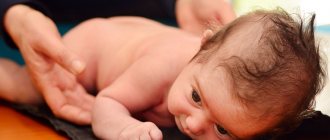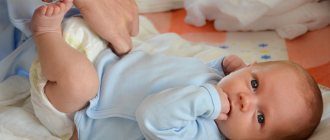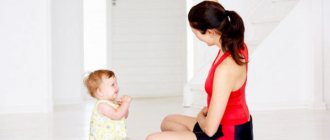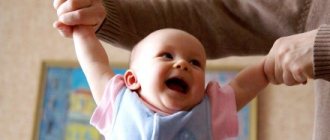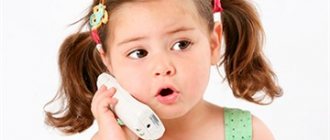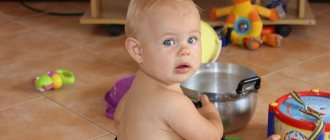How to develop a child at 4 months? What games and exercises does he need? What is most important in a child's development? We started talking about this in the first part, “Baby at 4 Months,” and today we will learn simple and very useful games, exercises for the baby, and mother’s gymnastics with nursery rhymes for a four-month-old baby.
We play with objects. Learning to grasp and hold a toy or object in your hand
Rings (Author – L.N. Pavlova. Candidate of Pedagogical Sciences)
Take rings of different colors with a diameter of 10-12 cm and attach bells or bells to them. In further games, you need to change toys - give a ring of a different color, shufflers, rattles and other sounding objects.
Part 1. Show your baby the ringing ring. Place it in the baby's hand between the thumb and the other four fingers, wrap your hand around it so that the baby holds the ring.
Shake the ring and say the onomatopoeia: “ding-ding-ding.” Take a break. Release your hand, giving the baby the opportunity to play with the toy himself. Then give a ring of a different color.
Part 2. After this, tie the same toy to a ribbon at a height of 10-15 cm above the baby’s chest to the right or left of him. Bring the ring to the baby's palm so that it touches the fingers. This is how we encourage the child to grab the toy and pull it towards him.
Part 3: Repeat this exercise with your baby on your stomach.
On the! Take it!
Grab a rattle or brightly colored wooden spoon by the very tip. Show it to your baby, draw attention to the subject. Then say: “Here! Take it” and bring the object closer to the child (at the distance of his outstretched arm), allowing the baby to grab the toy by the handle and hold it in his hand.
Various toys
Place your baby on his tummy. Place objects (2-3) in front of him. For example, two rings of different colors and one cube (or any other object that differs in shape from the first two). The baby will begin to actively examine objects and at the same time learn to adapt hand movements to the shape of the object being grasped.
Give new objects each time in this exercise. You can give two three-dimensional objects and one flat one. Alternate shapes of different shapes (bar, cube, ball, cylinder, cone, etc.). You can take these figures from a children's construction set.
Rattles (bells)
Option 1. Hang rattles (bells) above the baby's crib on satin ribbons of different colors. The height of hanging toys above the child’s chest is 10-15 cm. The height is calculated as follows: the toys should be at the level of the baby’s bent or raised arms. Start rocking the rattles and touch them to your baby's hands. This encourages the child to grasp the toy and develop hand-eye coordination. The baby can not only grab the rattle, but also swing it left and right. After playing, remove the rattles.
Option 2. Tie a cord across the crib and hang bells (bells) on it. Tie bright colored satin ribbons to the bells. Place a ribbon in your child's hand and jingle it. With this exercise, we encourage the baby to grab the ribbons and cause the bells to gently ring.
Read a poem about bells to your child:
Dili-dili-dili-dili - The bells were ringing. Dili-dili-dili-dili - The bells woke me up. All the bugs, spiders and funny moths. Ding-day! Ding-day! Let's start a new day!
Garland (Author – L.N. Pavlova)
Make a garland of balls and cubes. The garland alternates details of different colors and shapes. To do this, string parts (balls and cubes with holes) measuring 3-4 cm onto a ribbon 150 cm long.
Place your baby on his tummy. His body should be half in the ring outlined by the garland. In front of the baby is a semicircle of garlands. Give the opportunity to look at the garland. If the baby is not interested, then move the ball closer to him. If the baby does not pull his hands, then you can take his hand and slowly pull the object with it. Name the figures: “Shaaaaarik! Kuuuubik!”, emphasizing the vowel sounds “a” and “u” (the baby already pronounces these sounds when humming). After 2-3 minutes, turn the baby onto his back and let him rest.
Next, help the child turn from his back to his stomach and show the toy again for 2-3 minutes.
The same exercises can be done with a garland of multi-colored bells and small toys.
Educational games for a 4 month old baby
Games for the development of coordination of movements, vision, hearing of a child at 4 months. First books for a four month old baby. What to play with a 4 month old baby?
Previous developmental activities with the mother were not in vain - now “grasping” has become a purposeful action of the baby. By the end of the 5th month, the child can grab, pull towards, hold, push, swing, twist, and lower objects of interest to him. Observe him while giving him a new toy. He will definitely touch it, twirl it and taste it. Actions quickly follow one another - the child sees the toy, grabs it and puts it in his mouth. After some time, a detailed inspection will be added to this clear order. Before putting an object in his mouth, the baby will study the “valuable thing” for a long time. Moreover, a four-month-old baby is already interested in such properties of objects as temperature and surface features. Satisfy his interest in the game! For example, let your baby hold and touch a cold and hot bottle or a piece of ice. It's okay if the baby sticks his fingers into warm porridge or jelly. This will be another step in understanding the world around us. Your child learns to consciously unclench his handle and let go of the object he was holding. Here he is throwing toys out of the crib. Enjoy your first experience of active interaction with your baby: he throws it, and you pick it up and put it in his hands again. This will be repeated many, many times, perhaps you will get tired of it. Prepare yourself to understand that all this is necessary for the child’s development, and accept it! If you are really tired, just switch your son or daughter's attention to another game. In the process of communication in the fifth month of life, what can be considered new is the appearance of a vivid emotional reaction to a familiar adult (parent, close relatives), whom the child already recognizes while being at a distance of 2-3 meters in an upright position (in the arms of another adult). The baby recognizes a loved one even by his voice, even though the latter does not fall into his field of vision. The child begins to react differently to the positive and negative intonation of an adult’s voice. So, for example, if an adult “tells him off”, i.e. they are unhappy, this may cause crying. At the same time, with affectionate and sufficient communication with an adult, the baby has an unusually friendly appearance and is mostly in a good mood, hums for a long time, melodiously and loudly, a stable, bright “a-a-a”, “a-a-a”, “au-a”, “ u-va, u-u-va”, etc.
We develop coordination of movements.
The most important stage in a child's development at the age of 4-6 months is the development of purposeful hand movements (coordination in the eye-hand system). Playing with a tumbler (developing a child’s ability to navigate in space, developing memory). Show the child lying on his back a toy. For example, a tumbler doll (1-2 min.) from a distance of 50 cm. Attract his attention by rocking the toy. Then smoothly move the toy so that it is on the side. Rock it again, attracting the baby's attention.
And now the child himself reaches out to the nesting doll, now located in front of him, reaches out with his hand, touches it, pushes it away, swings it, i.e. puts it into action. You can also show a tumbler doll to a child who is in the arms of another adult, i.e. from a vertical position (the baby should not be seated). The child is supported under the back. He “recognizes” the tumbler from a distance of 50-80 cm. An adult brings the baby to the toy, giving him the opportunity to explore it from a vertical position.
Game "Funny Ball". Your task is to teach your four-month-old baby to transfer a toy or any object from one hand to the other.
To play you will need a small colorful ball. The starting position of the baby is lying on his stomach. Hand the baby the ball, and after he takes it, start reading the nursery rhyme: “What a funny ball!” - Lightly squeeze the child’s hand with the ball and shake it. “He’s ready to take off at a gallop!” - Do not pull the ball too much so that the baby’s hand experiences muscle force. “It just begs to be played!” - Twitch the toy in the child’s hand, encouraging him to give up the ball. “It will be difficult to hold on!” - Direct the ball to the baby’s other hand, so that he can, or with your help, intercept the ball with his other hand. “The ball jumped and jumped, and got into our hands again!” - Be glad that the child has the toy again. As the game continues, change the baby’s hands, alternating between moving them to the left and then to the right hand. Why does a person have two hands? Teach your child to “work” with both hands at the same time and transfer toys from hand to hand.
Here is an excellent activity for developing the coordination of movements of a baby at 4 months: the baby holds the ring with one hand, and you give him a rattle in the other hand, then, lo and behold, you offer him a new musical (small to fit in one hand) toy for study.
What will the baby do? The new toy interested him, but he doesn’t want to release other toys. And so he transfers the rattle to the hand with the ring and easily takes the “new item”. Of course, this will not all work out so easily and quickly, try experimenting with different variations... Give the baby a large (for one hand) toy, and show how to hold it with both hands. Then offer it without first showing how it holds up.
First physics! The concept of cause and effect relationships.
- Build a small slide from available materials so that the child can clearly see what is happening. Now roll a small car on wheels (or any other toy) down this slide. This will be his first example of cause-and-effect relationships between phenomena. That's how!
- Buy your child a toy that makes a sound or a light effect when you press a button. However, psychologists advise paying attention to the fact that when repeated manipulations with the toy, it is possible to turn off the sound, or that the sound is short-lived. This way you will save yourself and your child from prolonged annoying “singing” that irritates the ears.
Developing vision.
Until now, the child could clearly distinguish objects located at a distance of 30-40 cm. Now, a four-month-old baby is able to focus his gaze regardless of the distance at which the object of interest is located. Therefore, you can safely study from the window the events taking place in the yard - being sure that the child sees everything.
Expanding our understanding of sound and speech.
The baby has already learned to pronounce vowel sounds correctly, articulately, in tune with his native language. This is an important milestone in its development.
A child's bawling at 4 months is “training” of achieved speech skills. It tells an adult a lot and, above all, that the child feels “on top.” At this age, it is necessary to talk with the baby more often, tell him about the world and surrounding objects in the house and on the street, listen to what he answers you. accompany any actions you share with him or her .
Make simple requests to him, and if he doesn’t quite understand yet, fulfill them for him. For example: “Misha, give mom the dog” (at this time he is holding it in his hands), then take the toy from his hands and thank him - “Thank you, my dear!” Of course, we must ensure that the baby does not have a negative reaction to this action. Change your intonation, combine speech with gestures and a certain facial expression. Every day the baby will understand spoken speech better and better. The child is already captivated by the variety of sounds and intonations. A four-month-old baby discovers that he can make special sounds and is happy when he hears them. He especially likes some of them, such as a high-pitched scream, inarticulate muttering, and coughing, and repeats them over and over again. So he has fun, making either very loud or quiet sounds, enjoying the effect he produces.
And the baby.
Is your baby difficult to “talk” to? You can enhance his speech development. To begin with, create an atmosphere of silence, giving the child the opportunity to express himself with vocalizations and speech reactions. It often happens that the TV or music is constantly on at home; it is difficult for a child to navigate in this world of constant sound. The baby needs to “hear” himself. The child begins to “walk” and chant vowel sounds, articulating them clearly and correctly. If creating absolute silence is still not enough “to give a push,” a tape recording of his own voice is used. It is advisable to make such a recording at moments when the child is in a good mood, cheerful and “booming,” as they say, with all his heart during waking hours. You will see that the baby, having listened, will begin to repeat his own vocal reactions. Talk to your baby kindly. Then after a pause (5 seconds) strictly, then again affectionately. When a child hears a gentle intonation, he perks up, but when he hears a stern one, he frowns and may even cry. This contributes to the emotional development of the baby.
We learn to speak the first syllables.
At the age of five months, the child already makes his first attempts to pronounce any one syllable (“ba”, “ma”). And, listening to an adult, sometimes he can repeat the syllable after him. Watch his speech carefully: the baby accidentally said “ba-a”, cheerfully repeat after him, he will follow you - and so on several times. Try saying “boo” after a few “bahs,” and you will see how amused the child is.
First books.
Live communication with a book at the age of four months , which the baby “reads” with his mother, is a leap forward in the development of his speech development, as well as imaginative thinking and intelligence, and expansion of his worldview. A good book generously fills a child’s need for new information and gives him new impressions that will stay with him for life.
Meet - it's you! Drop all superstitions! A mirror can be a fun toy for a 5 month old baby. An unbreakable mirror attached to a pendant or toy is an endless source of pleasure. Looking at it, the child observes facial expressions and hand movements, catches the gaze of his “double” and smiles at him. The main thing is that it is not too small, and the baby can see, if not himself completely, then at least his face, and not the edge of his eye or ear. Ideally, if the baby has two mirrors - one that you can turn in your hand and look at your face, and the other, which can sometimes be placed near the child’s play area, in it he will be able to see himself and his movements entirely. Let's help the baby explore his body. At 5 months, the baby is actively becoming acquainted with his body. Help your baby explore his body. Be sure to show and name parts of the body - legs, arms, tummy, as well as parts of the face - eyes, mouth, nose... These games can be played at any time, and also during a massage, changing clothes.
- You can play like this: Ask your child a question: “Where is Misha’s leg?” - and answer yourself, pointing to the leg - “Here is the leg!” After this, you can kiss the leg.
- Or like this: Make a sound that is especially interesting to the baby (to immediately attract his attention - for example: “slap-slap”!) and immediately touching the leg, say, “This is a leg!” And so with all parts of the body. The baby will get used to it the next time you call invitingly “slap-slap!” - he will already wriggle his whole body with admiration, waiting for your touches and play.
Don't be alarmed if you see your child touching his genitals. This is quite natural. Only the situation should cause concern if the baby does this constantly. Perhaps this behavior indicates that the baby is experiencing constant discomfort in the genital area (for example, if there is irritation there). In any case, do not focus his attention “there”. If you notice that the child is pulling his hands towards the genitals, calmly and simply say what it is, in the same tone as you explained where the nose, mouth, and eyes are. And then distract him by directing his hand on a further “tour” through the body. Your negative reaction and slaps on the hands will only fix the baby’s attention in the “forbidden zone.” I look at you as if in a mirror... (development of facial expressions). Make faces at your baby, make him different faces, show him your tongue, and you will see that he is trying to copy you! It's very fun and useful for developing facial expressions. At the same time, you can read and dramatize this positive rhyme for your little one: “We are funny monkeys! We play too loud! We clap our hands! We're stomping our feet! Let's puff out our cheeks! Let's jump on our toes! And we’ll even show each other our tongues! Let's jump to the ceiling together! Let's put our finger to our temple! Let's stick out our ears! Ponytail on top! Let's open our mouths wider! We’ll all make faces!”
We develop visual concentration on an object, the ability to trace the trajectory of its movement
Where's the toy?
By 4 months, a baby who has been given exercises to develop the ability to follow a moving object can not only smoothly move his gaze, but also trace with his eyes the invisible trajectory of the object.
Take a bright toy and attract the baby’s attention to it (show it to the child, make a sound). When the child fixes his gaze on the toy, start moving it and then put it behind a NARROW screen 7 cm wide. Then the toy continues its “route” behind the screen (the child does not see it) and appears on the other side of the screen. Show this “toy’s journey” 3-4 times, and the child will wait for the toy to appear in the place where it appeared before.
Staring contest: following with your eyes
Place your baby on his back. Show him a bright sounding toy (it should be easy to grasp). When your baby focuses his eyes on the toy, start moving it in a circle. Gradually increase the diameter of the circle. After this, give the toy to the baby so that he can grab it and examine it.
At this age, the baby is already able to easily follow with his eyes the complex trajectories of a toy’s movement - therefore, you can complicate the task by moving the toy vertically, horizontally, in a figure eight or along another trajectory.
Also see if your baby can follow your face with his eyes. Start talking to him (the baby lies on his stomach, your face is at the level of his face), and then move first left and right, then up and down. At the same time, talk to the child, call him by name, read nursery rhymes. It is important that the child steadily follows your face in different directions with his gaze.
What toys does a baby need?
For a 4-5 month old baby, toys are suitable that will meet the following requirements:
- Conveniently shaped and with the right handle so that the baby is able to learn the correct grip.
- Safe. It is necessary to take into account that the little one may try to chew them.
- Suitable sizes for baby's age. Small parts are contraindicated.
- Toys of different shapes and colors (preferably no more than 6 primary colors).
- Musical accompaniment or sound effect.
A child of 4-5 months is already trying to actively explore the small world around him, so his toys become more diverse.
Here is a list of necessary toys for the development of a child at 4-5 months:
- Pendants and rattles. The baby will happily watch them and try to reach them.
- Balls and cubes made of soft material.
- Musical. They will have a positive effect on the child’s hearing development.
- Special beads. Will promote the development of fine motor skills.
- Tumblers and dolls. It is important for a child to play with toys that imitate living people.
- Mirror. The little one will admire his reflection in the mirror, smile and even laugh.
- Mats for development. Multifunctional facility. Any little one will like it.
Development of auditory concentration
Where does the sound come from?
In this exercise, the baby learns to turn his head towards an invisible sound source and focus his gaze on it. Take a sounding object - a rustling object, a shuffler, a rattle, a children's musical instrument (you already read what toys a baby needs and how to use them to create a developmental environment in the first part of this article) and start making sounds with it. The baby will turn his head towards the sound. Then walk around the playpen or crib, sounding the toy - the baby follows the moving sound source with his eyes.
After this, tap the toy on the sides of the crib in different places - the child will turn his head towards the sound source.
Sound the toy from different directions, pause, talk to the baby, encourage him to turn his head in different directions.
Always do such exercises, causing turns in different directions - left and right!
Getting to know the world around us
Here's my family!
Take the baby in your arms, bring him to family members, call them, touch them with your baby’s hand. Read a poem about family, pointing the baby's hand to the named person. Let them talk to the baby.
I know that I have a friendly family at home: This is my mother, this is me. This is my grandmother! This is dad, this is grandfather. And we have no discord!
Who is this?
The exercise develops the child’s indicative reaction to the mother’s voice and her face. While talking with your baby, make changes to your appearance - for example, put on a hat or tie a scarf, pin up your hair, etc. The baby will be wary. But recognizing your voice, he smiles.
You can play hide and seek. During a conversation, hide your face with a handkerchief and pull the child's hand towards the handkerchief. The baby will pull off the scarf and see his mother.
Two bottles
Offer your baby two bottles. Will he be able to make a choice based on the color of a bottle with different liquids (a transparent bottle of water or an opaque white milk mixture)
Traveling around the apartment
The child should be carried in your arms around the apartment more often and you should talk to him at the same time, name objects and actions. This not only allows you to familiarize yourself with the outside world and develop the prerequisites for speech, but also plays an important role in the formation of three-dimensional vision. Indeed, on such a journey, the baby sees the same object from different sides, from different vantage points.
Toy display
Place your baby on his stomach. Place a bright toy at a distance of 50 cm from it. Start showing off the toy. Name its parts, color, size, actions, show how to play with it, how it sounds. Use short poems about toys, nursery rhymes. Then give your baby the opportunity to play with the toy and reach for it.





